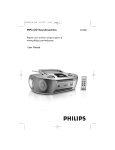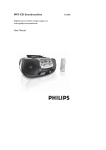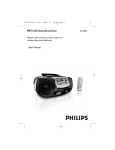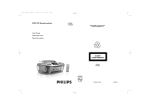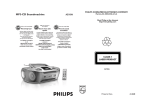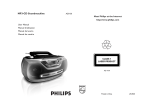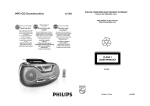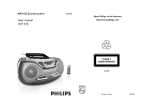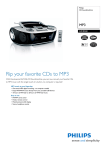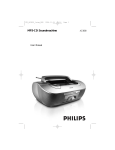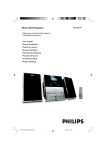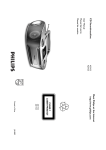Download Philips AZ1836B MP3 CD Soundmachine
Transcript
ifu_az1836_latam_eng 2006.8.23 11:38 AM Page 1 MP3-CD Soundmachine AZ1836 AZ1836 B Meet Philips at the Internet http://www.philips.com User Manual Manual del usario Manual do usuário W CLASS 1 LASER PRODUCT AZ1836 AZ1836B Printed in China JH-0633 ifu_az1836_latam_eng 2006.8.23 11:38 AM Page 2 1 1 9 2 0 3 4 5 6 7 8 ! 2 9 3 0 4 ! @ 5 # PHONES $ AC MAINS~ % 6 ^ X 6 x R14 • UM-2 • C-CELLS 7 1 3 5 CD USB MODE PROG ALBUM 9 DEL REC 2 4 6 7 8 0 8 ifu_az1836_latam_eng 2006.8.23 11:38 AM Page 3 English @ Supplied accessories – AC power cord Removing the insulation plastic tab 1 2 A CR 2 02 LI TH 5 3 IUM L I T HI 2025 CR U M – Remote control B Top and front panels (See 1) 1 Source selector: CD/USB, FM, MW, OFF – selects CD/MP3-CD (or USB mode), or radio – switches off the set 2 2; – starts or pauses disc/USB playback ∞§ – For disc/ USB play: – skips to the beginning of a current/ previous/ later track – fast searches backwards and forwards within a track 9 – stops disc/USB playback; – erases a program PROG – programs tracks and reviews the program 3 Display – shows disc/USB play functions # 4 ALBUM +/– For MP3-CD/ WMA/USB play: select albums 5 USB REC – copy one file or all files of a disc to an external portable USB storage device/MP3 player 6 iR – infrared sensor for remote control 7 CD/USB – enters disc or USB mode 8 MODE – selects different play modes: e.g. REPEAT or SHUFFLE (random order) 9 OPEN•CLOSE – opens/ closes the CD door 0 TUNING – tunes to radio stations ! VOLUME – adjusts volume level @ USB port – connects an external USB mass storage device USB mass storage device USB cable Controls / Power Suppy Back panel (See 1) # Telescopic antenna – improves FM reception $ p – 3.5 mm stereo headphone socket Helpful hints: The speakers will be muted when headphones are connected to the set. % AC~ MAINS – inlet for power cord ^ Battery door – open to insert 6 x 1.5V R-14/ UM2/ C-cells & Voltage selector – adjust to match the local voltage 110/220V. Remote control (See 1) 1 CD – enters disc mode 2 USB – enters disc or USB mode 3 MODE – selects different play modes: e.g. REPEAT or SHUFFLE (random order) 4 PROG – programs tracks and reviews the program 5 9 – stops disc/USB playback; – erases a program 6 2; – starts/ pauses CD/USB playback 7 ∞§ For disc/ USB play: – fast searches back and forward – skips to the beginning of a current track/ previous/ later track 8 ALBUM +/For MP3-CD/USB play: selects albums 9 DEL – deletes one file or all files stored on the external USB device 0 REC –copy one file or all files of a disc to an external portable USB storage device/MP3 player Power Supply Whenever convenient, use the power supply cord if you want to conserve battery life. Make sure you remove the plug from the set and wall outlet before inserting batteries. ifu_az1836_latam_eng 2006.8.23 11:38 AM Page 4 Power Supply • Batteries Main set (See 1) Insert 6 batteries, type R-14, UM2 or Ccells (not included, preferably alkaline) with the correct polarity. 3 4 To switch the set off completely, withdraw the power cord from the wall socket. 1 Remote control 5 Install the unit near the AC outlet and where the AC power plug can be easily reached. 2 Important! • Before using the remote control, remove the insulation plastic tab as shown in figure @. • If the remote control does not function correctly or the operating range is reduced, replace the battery with a new (CR2025) type battery 1 Press and hold the latch (A) in the direction as shown in figure @. 2 Simultaneously, pull the battery tray (B) out. 3 Replace a new battery, and fully insert the battery tray back to the original position. • • Basic Function/ Radio Incorrect use of batteries can cause electrolyte leakage and will corrode the compartment or cause the batteries to burst: • When inserting new batteries, do not try to mix old batteries with the new ones. • Remove the batteries if the set is not to be used for a long time. Batteries contain chemical substances, so they should be disposed of properly. Disconnect the power cord from the wall socket to protect your set during heavy thunderstorms. Children could seriously injure themselves as the free end of the cable may still be live if only the connector is removed from the MAINS socket at the back of the unit. The type plate is located on the bottom of the set. • • Do not mix battery types: e.g. alkaline with carbon zinc. Only use batteries of the same type for the set. • Connect the power cord to the AC~ MAINS inlet and the wall socket.The set is now ready for use. – Auto power saving When the source selector is adjusted to CD/USB and the set is in the PAUSE position for 5 minutes, the set will be auto switched to the stop position to save power. When the source selector is adjusted to CD/USB and the set is in the STOP position for 15 minutes, the set will be auto switched to sleep (standby )mode.To wake it up, press 2;. MP3-CD/ CD Player Basic functions About MP3 Switching on/off the set To switch on, adjust the source selector to CD/USB, FM or MW as desired. The music compression technology MP3 (MPEG1 Audio Layer 3) significantly reduce the digital data of an audio CD while maintaining CD quality sound. To switch off, adjust the source selector to OFF. • legal music files from the internet to your computer hard disc, or create such files by converting audio CD files in your computer through appropriate encoder software. (128kbps bit rate or higher is recommended for MP3 files.) Adjusting volume Adjust the volume with the VOLUME control. Radio reception 1 Push the source selector to FM or MW. 2 Turn TUNING to tune in a radio station. 3 To switch off the radio, adjust the source selector to OFF. • – Make sure that the file names of the MP3 files end with .mp3 or .wma. – Number of albums: maximum 500 – Number of tracks: maximum 1000 – The length of file names affects the number of tracks for playback. With shorter file names, more files can be burned on a disc. To improve reception For FM, extend, incline and turn the telescopic antenna. Reduce its length if the signal is too strong. • For MW, uses a built-in antenna. Direct this antenna by turning the whole set. Helpful hints: To avoid unnecessary energy consumption, always adjust the source selector to OFF after using the set. Using AC power CAUTION 1 Check if the power/mains voltage, as shown on the type plate located on the bottom of the set, corresponds to your local power supply. If it does not, consult your dealer or service center. Use of controls or adjustments or performance of procedures other than herein may result in unsafe operation. 2 If your set is equipped with a voltage selector, adjust the selector so that it matches with the local power supply. Creating a MP3 CD: burn the music files from your computer hard disc on a CDR or CDRW using your CD burner. Helpful hints: Helpful hints: • Getting MP3 files: you can either download Playing a disc This player plays Audio Discs including CD-R/ CD-RW, MP3 CD and WMA. Do not try to play a CD-ROM, CD-I, CDV,VCD, DVD or computer CD. IMPORTANT! • CDs encoded with copyright protection technologies by some record companies may be unplayable by this product. • DRM-protected WMA disc is not supported. 1 Adjust the source selector to CD/USB. ➜ Display shows - - - (see 2), or - - - with “USB” (see 3) ifu_az1836_latam_eng 2006.8.23 11:38 AM Page 5 MP3-CD/ CD Player 2 MP3-CD/ CD Player Press CD/USB to enter CD mode if USB is displayed. ➜ Display will show --- (See 2). 3 Open the disc door. 4 Insert a disc with the printed side facing up and press the disc door gently to close. ➜ Display:The total number of tracks appears. 1 2 ➜ The disc scanning of MP3-CD may run longer than audio CD. 5 Press 2; to start playback. ➜ Display: 2 and the current track number. For MP3-CD/ WMA only: ➜ The current track number “XXX“ and album number “ALB XXX“ will be displayed interchangeably (See 4 5). 6 To pause playback press 2;. ➜ Display: 2 and the current track number flash. 7 Press 2; again to resume playback. 8 To stop playback, press 9. – – – Helpful hints: The disc playback will also stop when: you open the disc compartment door; you select FM, AM or OFF position; the disc has reached the end of the playback. Selecting a different track • Press ∞ or § once or repeatedly until the desired track number appears in the display. For MP3-CD/WMA: First press ALBUM+/- once or more to find your album. • In the pause/stop position, press 2; to start playback. To erase a program You can erase a program by: – pressing 9 (twice during playback or once in the stop position); – selecting FM, MW or OFF position; – opening the disc door. ➜ Display: PROG disappears. Finding a passage within a track During playback, press and hold down ∞ or §. ➜ The disc is played at high speed and low volume. When you recognize the passage you want, release ∞ or §. ➜ Normal playback resumes. Selecting different play modes (See 7) You can select and change the various play modes before or during playback, and combine play modes with PROG. Programming tracks You may store up to 20 tracks in the desired sequence. If you like, store any track more than once. 1 2 3 REP – plays the current track continuously. REP ALL – plays the entire disc/program continuously. In the stop position, press PROG to start programming. ➜ Display shows P01 indicating the start of the program. PROG flashes. (See 6) Press ∞ or § to select your desired track number. 1 To select play modes, press MODE once or more. 2 For MP3-CD/WMA: First press ALBUM+/- once or more to find your album. Press 2; to start playback if in the stop position. 3 To select normal playback, press MODE repeatedly until the various modes are no longer displayed. – You can also press 9 to cancel your play modes. Press PROG to store the desired track. ➜ Display shows P02, indicating the next program location available. 4 Repeat steps 2 to 3 to select and store all desired tracks. 5 Press 2; to play the program. To review your program In the stop position, press and hold PROG 3 seconds. ➜ The display shows all the stored tracks in sequence. Helpful hints: – Display shows P01 if no track is programmed. – If you try to store more than 20 tracks, no track can be stored and the display will show FUL. SHUF – plays all tracks in random order. USB Connection Using USB connectivity • AZ1836 is fitted with a USB port in the front panel, offering a plug and play feature which allows you to play, from your AZ1836, digital music and spoken contents stored on a USB mass storage device. • Using a USB mass storage device, you can also enjoy all the features offered by AZ1836 which are explained and instructed in the sections of disc operation. Compatible USB mass storage devices With the AZ1836, you can use – USB flash memory (USB 2.0 or USB 1.1) – USB flash player (USB 2.0 or USB 1.1) • USB device which requires driver installation under Windows XP is not supported. Note: In some USB flash players (or memory devices), the stored contents are recorded using copyright protection technology. Such protected contents will be unplayable on any other devices (such as AZ1836 device). Supported formats: – USB or memory file format FAT12, FAT16, FAT32 (sector size: 512 - 4096 bytes) – MP3 bit rate (data rate): 32-320 kbps and variable bit rate – WMA v9 or earlier – Directory nesting up to a maximum of 8 levels – Number of albums: maximum 500 – Number of tracks: maximum 1000 – ID3 tag v2.0 or later – File name in Uicode UTF8 (maximum length: 128 bytes The system will not play or support the following: • Empty albums: an empty album is an album that does not contain MP3/WMA files, and will not be shown in the display. ifu_az1836_latam_eng 2006.8.23 11:38 AM Page 6 USB Connection USB Connection • Non-supported file formats are skipped. This means that e.g.: Word documents .doc or MP3 files with extension. dlf are ignored and will not be played. • AAC, WAV, PCM. NTFS audio files • DRM protected WMA files • WMA files in Lossless format 1 2 3 Playing a USB mass storage device Make sure that your AZ1836 is being powered by AC mains or specified batteries. AZ1836 allows you to copy the music files or spoken contents of a disc to the external USB device.You can record one track, the whole disc or even selected tracks through the Program function. 1 2 Adjust the source selector to CD/USB. ➜ Display shows - - - (see 2), or - - - with USB (see 3) 3 Press CD/USB to enter USB mode if USB is NOT displayed. 4 ➜ Display will show USB (see 2). As shown in figure # , plug a compatible USB mass storage device to AZ1836’s USB port marked . If needed, use a suitable USB cable to connect between the device and AZ1836’s USB port. ➜ The device will automatically power on. • If the device is not powered on, turn on the power manually, then re-connnect it. ➜ AZ1836’s display shows USB and the total number of playable audio files (Max. displayed track number is 1000) stored on the device. 4 5 CD Ripping - Recording disc files to a USB device Press 2; on your AZ1836 to start play. ➜ AZ1836’s display will show USB and share the display information illustrated in the disc operation. Helpful hints: – Make sure that file names of MP3 files end with .mp3. and the file names of WMA files end with .wma. – For DRM protected WMA files, use Windows Media Player 10 (or later) for conversion. Visit www.microsoft.com for details about Windows Media Player and WM DRM (Windows Media Digital Rights Management). – For USB device playing, if the display shows "OL", it means that the USB device is electrically overloading AZ1836.You need to change a USB device. Adjust the source selector to CD/USB. Insert a disc (audio CD or MP3 or WMA). If desired, program the disc. Press CD/USB to enter CD mode if USB is displayed. Plug a USB mass storage device. To record one 5a Select the track you want to record. 5b Press once or repeatedly USB REC (or REC on the remote) until ONE appears, flashing. ➜ Disc playback will start automactially from the beginning of the selected track. ➜ REC is displayed, and ONE will flash 2 seconds then disappear (see 8). To record all 5a Press repeatedly USB REC (or REC on the remote) until ALL appears, flashing. ➜ Disc playback will start automactially from the beginning. ➜ REC and ALL are displayed, and ALL will flash 2 seconds then disappear (see 9). To stop recording, first press 9, then unplug the USB device. • In the record-one mode, the playback will auto go to the stop position after one track/file comes to an end. • During MP3 and WMA recording, make sure the playback of the file you want to record is wholly completed before manually stop recording. Or any part of the file will not be recorded. • During recording, if the memory of the USB device runs out, playback will not continue. 6 Recorded files managing • In your USB device, a folder named_PHILIPS will be automatically created to manage all the recorded audio files. • Under _PHILIPS folder, sub-folders starting from F001, F002, F003... will also be created to store the files recorded at different recording intervals (such as changing disc, re-plugging the USB device). • The recorded file(s) will be stored in either .mp3 format (for CDDA music or MP3 file), or .wma format (for WMA file). • For MP3 and WMA file, the file name will be directly copied as recorded file name. For CDDA music file, the file name will be changed to F001T001, F001T002.... Helpful hints: – In recording mode (even the USB device is unplugged from the set), selections of track/album, play modes (repeat and shuffle modes) are not available. – Copyright-protected CD will not be recorded. – DRM-protected WMA is not supported. – Do not directly unplug the USB device to stop recording for a possible loss of some of the recorded contents. – For some USB device of low speed, the playback may go with muted sound for some seconds which will depend on the capability of the low-speed USB device. – During recording, if "Prt" is displayed, it means that the disc/file being played is either copyright-protected CDDA disc or DRM-protected WMA file. Such disc/file will not be recorded. You need to change CD, or skip track(s). – During recording, if the display shows 2-second-flashing "Err", then "tr", it means that the file being played is invalid (un-recordable). You need to skip track(s). – During recording, if the display shows 2-second-flashing "Err", then "dup", it means that the file being played has been previously recorded due to the same file name as the previously recorded one. You need to skip track. Or you need to switch off and on again the set, a new sub-folder will be created to record it. Deleting audio files/album on a USB device Adjust the source selector to CD/USB. Press CD/USB to enter USB mode if USB is NOT displayed. 3 Plug a USB mass storage device. 4 Select the track you want to delete before or during playback. • In the stop position, you may select an album to delete. 1 2 5 6 7 Briefly press DEL on the remote. ➜ “DEL” is displayed, flashing (see 0). To delete it, press DEL again. ➜ The playback of the USB device will come to the stop position. To not to delete, wait until flashing “DEL” disappears after 4 seconds of flashing, or just press 9. Helpful hints: – For some MP3 players, AZ1836 will read it as only one folder which will wrap up all the audio files on the player regardless of more than one folder on that player. – AZ1836 may not be able to delete a file /albume stored on some MP3 players. The making of unauthorized copies of copy-protected material, including computer programmes, files, broadcasts and sound recordings, may be an infringement of copyrights and constitute a criminal offence.This equipment should not be used for such purposes. ifu_az1836_latam_eng 2006.8.23 11:38 AM Page 7 Safety & Maintenance (See !) Safety information • Place the set on a hard, flat and stable surface so that the system does not tilt. • Do not expose the set, batteries, CDs to humidity, rain, sand or excessive heat caused by heating equipment or direct sunlight. • The apparatus shall not be exposed to dripping or splashing. • Adequate ventilation with a minimum gap of 15 cm between the ventilation holes and surrounding surfaces is necessary to prevent heat build-up. • The ventilation should not be impeded by covering the ventilation openings with items, such as newspapers, table-cloths, curtains, etc.. • No objects filled with liquids, such as vases, shall be placed on the apparatus. • No naked flame sources, such as lighted candles, should be placed on the apparatus. • The mechanical parts of the set contain self-lubricating bearings and must not be oiled or lubricated. • To clean the set, use a dry cloth. Do not use any cleaning agents containing alcohol, ammonia, benzene or abrasives as these may harm the housing. CD player and CD handling • If the CD player cannot read CDs correctly, use a cleaning CD to clean the lens before taking the set to repair. • The lens of the CD player should never be touched! • Sudden changes in the surrounding temperature can cause condensation on the lens of your CD player. Playing a CD is then not possible. Do not attempt to clean the lens but leave the set in a warm environment until the moisture evaporates. • Always close the CD door to avoid dust on the lens. • To clean the CD, wipe in a straight line from the center towards the edge using a soft, lint-free cloth. Do not use cleaning agents as they may damage the disc. • Never write on a CD or attach any stickers to it. Environmental information All unnecessary packaging material has been omitted.The packaging can be easily separated into three materials: cardboard, polystyrene and plastic. Your set consists of materials which can be recycled if disassembled by a specialized company. Please observe the local regulations regarding the disposal of packaging, dead batteries and old equipment. Troubleshooting If a fault occurs, first check the points listed below before taking the set for repair. If you are unable to remedy a problem by following these hints, consult your dealer or service centre. WARNING: Do not open the set as there is a risk of electric shock. Under no circumstances should you try to repair the set yourself, as this will invalidate the guarantee. No sound/ power – • – • – • – • Volume not adjusted Adjust the VOLUME Power cord not securely connected Connect the AC power cord properly Batteries dead/ incorrectly inserted Insert (fresh) batteries correctly Disc contains non-audio files Insert a suitable disc or press ∞ or § once or more skip to an audio track, instead of the data files. Display does not function properly/No reaction to operation of any of the controls – Electrostatic discharge • Switch off and unplug the set. Reconnect after a few seconds. no indication – • – • – • – • – • It is set in the USB mode. Press CD/USB to select CD mode. No disc inserted Insert a suitable disc Disc badly scratched or dirty Replace/clean CD (See Maintenance) CD-R(W) is blank or the disc is not finalized. Use a finalized CD-R(W) Laser lens steam up Wait until lens has cleared. Note: Make sure the CD is not encoded with Copyright protection technologies, as some do not conform to the Compact Disc standard. The disc skips tracks – Disc damaged or dirty • Replace or clean disc – Shuffle or program is active • Switch off shuffle/program Sound skips during MP3 playback – MP3 file made at compression level exceeding 320kbps • Use a lower compression level to record CD tracks into MP3 format – Disc damaged or dirty • Replace or clean disc. Note: DRM-protected WMA disc is not supported. The USB device doesn’t play on my AZ1836 – It is not set in the USB mode. • Press CD/USB to select USB mode. – The device is not securely connected to AZ1836’s USB port. • Re-connect the device, and make sure that the device is powered on. – The device is not supported by AZ1836, or the audio file format stored on the device is not supported by AZ1836. • Use a compatible device/ playable audio file format. The disc file cannot be recorded to the USB device – You stop recording when the MP3 or WMA file you want to record is still playing. • Select record-one mode to record, or stop recording only when the playback of MP3 or WMA file is wholly completed. – The memory of the USB device runs out. • Delete some unwanted files on the USB device to free some memory, or use another USB device of sufficient free memory to record. – The name of a MP3 or WMA file on the disc is identical to the one of a file on the USB device. • Change to a different name for the file on the USB device. ifu_az1836_latam_eng 2006.8.23 11:38 AM Page 8 Mexico Es necesario que lea cuidadosamente su instructivo de manejo. PRECAUCIÓN - ADVERTENCIA No abrir, riesgo de choque eléctrico ATENCIÓN Verifique que el voltaje de alimentación sea el requerido para su aparato Para evitar el riesgo de choque eléctrico, no quite la tapa. En caso de requerir servicio, dirijase al personal calificado. Descripción: Modelo: Radio MW/FM con reproductor de CD/CD-MP3 AZ 1836(B)/55 Alimentación: Consumo: Importador: Domicilio: 110–127/220–240 V; ~50–60 Hz 14 W Philips Mexicana, S.A. de C.V. Av. La palma No. 6 Col. San Fernando la Herradura, Huixquilucan Localidad y Telefono: Edo. de México C.P. 52784 Tel. 52 69 90 00 Philips Electronics Hong Kong Ltd. China ______________________________________ Exportador: País de Origen: Nº de Serie: LEA CUIDADOSAMENTE ESTE INSTRUCTIVO ANTES DE USAR SU APARATO. AVISO IMPORTANTE Philips Mexicana, S.A. de C.V. no se hace responsable por daños o desperfectos causados por: – Maltrato, descuido o mal uso, presencia de insectos o roedores (cucarachas, ratones etc.). – Cuando el aparato no haya sido operarado de acuerdo con el instructivo del uso, fuera de los valores nominales y tolerancias de las tensiones (voltaje), frecuencia (ciclaje) de alimentación eléctrica y las características que deben reunir las instalaciones auxiliares. – Por fenómenos naturales tales como: temblores, inundaciones, incendios, descargas eléctricas, rayos etc. o delitos causados por terceros (choques asaltos, riñas, etc.).








